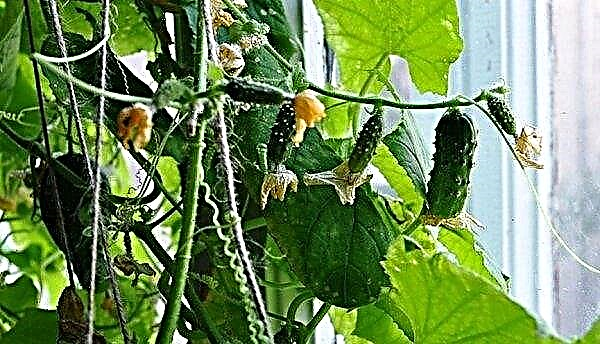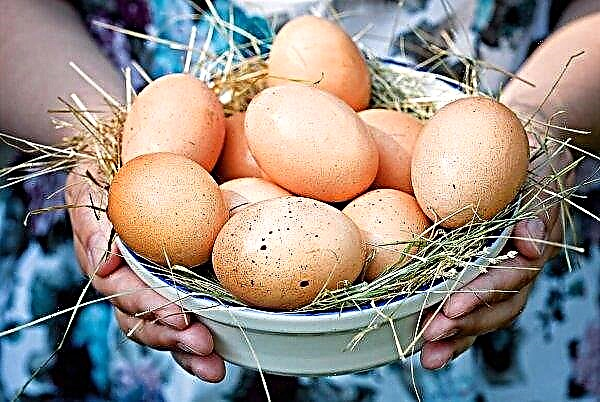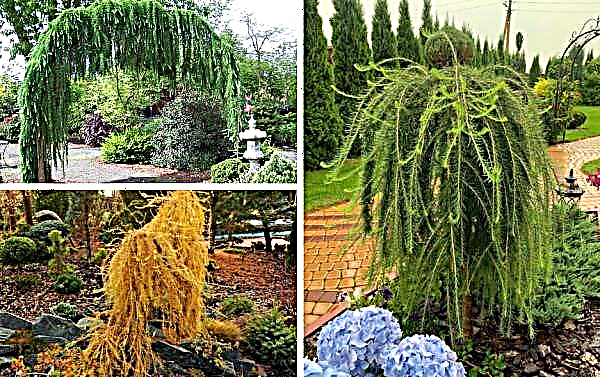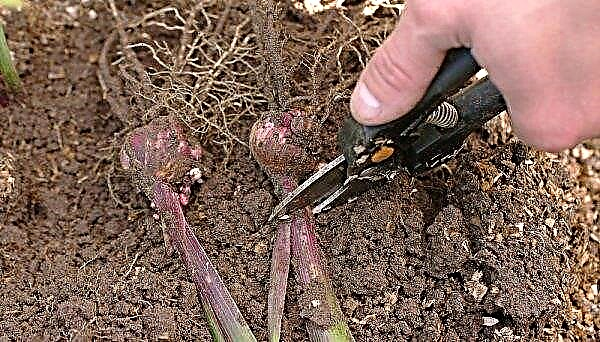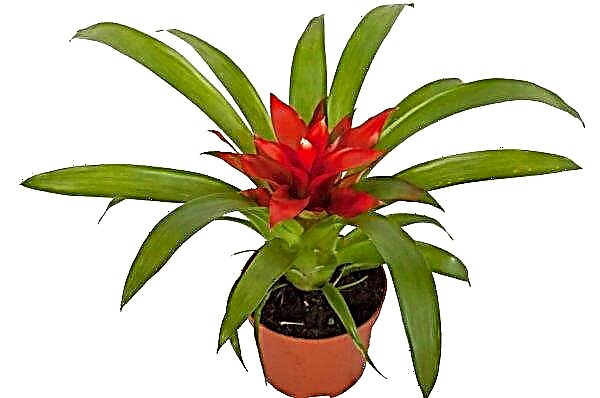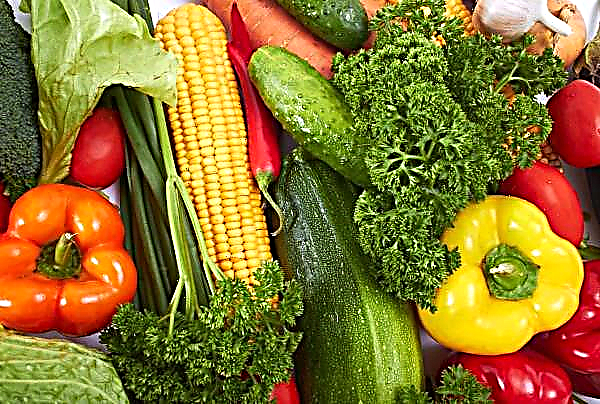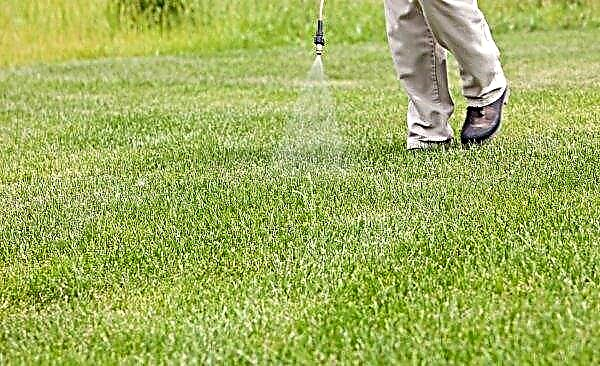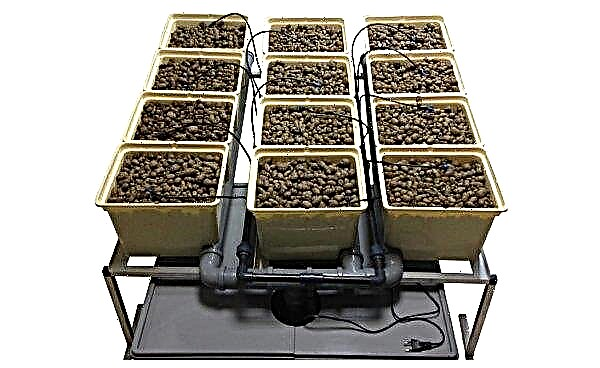In the cold and rainy summer, gardeners often think about ways to accelerate the ripening of tomatoes. For this, some resort to methods of chemical treatment of plants, others focus on the conditions of their growth, and others are limited to the agrotechnical tricks of forming a bush. What will actually help green fruits to pour early and redden without harming human health, and which technologies are categorically contraindicated during the fruiting period of solanaceous crops, we will talk about this later in the article.
Reasons for the slow ripening of tomatoes
The key to a good harvest of tomato beds are comfortable conditions for growing plants. We are talking about moderate humidity, appropriate temperature conditions, fertile and loose soil, timely pest control and the prevention of typical diseases, as well as high-quality seed.
Did you know? For a long time, tomatoes were considered inedible and deadly fruits. In Europe, they could be seen exclusively as ornamental garden plants, and American botany textbooks included the story of how in one restaurant a bribed cook tried to poison George Washington with a tomato dish.
The slightest violations in the care of the culture will not have the best effect on the quantity and quality of its fruits. That is why for a successful cultivation of tomatoes, the grower should know the main factors that slow down the ripening of the crop:
That is why for a successful cultivation of tomatoes, the grower should know the main factors that slow down the ripening of the crop:
- Violation of the thermal regime. This problem can occur both in the greenhouse and on the open ground. A sharp cooling at the stage of ovary formation often leads to the shedding of already dusty flowers. Moreover, like excessively high temperatures, cold kills pollen viability. If pollination was successful and the fruits were tied to the stems, it takes warmth to ripen on time. The experts consider the optimum temperature for growing tomatoes to be +24 ... + 28 ° C during the day and +17 ... + 19 ° C at night. In case of short-term cloudy weather, the thermometer +20 ... + 22 ° C is acceptable.
- Dampness. Increased humidity contributes to the development of late blight and prevents the formation of ovaries. Often this problem occurs in tightly clogged greenhouses and in open areas where plants are not tied to a support. The inability to ventilate, as well as the outflow of excessively heated and moistened air contributes to the adhesion of pollen and thereby prevents pollination of inflorescences. It is important to ensure that the humidity on the tomato bed does not exceed 65%. Experienced vegetable growers know that in the flowering phase, the crop needs good ventilation and low moisture levels. Therefore, in hot weather, it needs to be helped by lightly splashing the windows of the greenhouse with a weak chalk solution. To save the tomatoes growing on the garden bed, it would be useful to tie the stems to the support and regularly shake the excess dew by tapping the twine with a stick. If the inflorescences continue to crumble, it is recommended to spray them with special stimulants.
- Catastrophic soil moisture deficit. High demand for intensive irrigation of tomatoes is observed during the formation of the ovary and ripening of fruits. With a lack of moisture, they do not have time to fill up and begin to crumble. That is why it is impossible to prevent the formation of a dry crust in the root hole, as well as the drying of the soil. Therefore, large breaks between irrigation are contraindicated. According to experts, in order for the tomatoes to grow well and turn red in time, it is necessary to maintain humidity at the level of 70–75%.
- Lack or untimely feeding. When planting tomato seedlings, you must immediately be prepared for the fact that in the future you have to deal with a very demanding food culture. It responds well to nitrogen-containing substances, but with their excess is characterized by violent development of biomass and weak fruiting. Based on the characteristics of the effect of nitrogen fertilizers, it is necessary to strictly control their quantity on the bed, especially on dry and hot days.
- Carbon shortage. The problem is relevant for greenhouse plants that grow in soil with an insufficient amount of organic fertilizers. In order for the formed ovary to begin to enter the ripening phase, it is advisable to prepare in advance a special container for fermenting chicken droppings. It is half filled with grass or fresh manure and poured cold water to the top. Such top dressing not only stimulate the intensive development of fruits, but also increase the resistance of plants to adverse factors.
- Poor seed home production. A significant deterioration in the main breeding characteristics of the variety manifests itself at the 5–6 year of sowing, however, any violations of seed collection, as well as their storage, adversely affect yield. In this regard, specialists draw the attention of vegetable growers to the totality of the set of constant characteristics characteristic of each variety. But when collecting seeds at home, people often focus only on early maturity, size and number of fruits, ignoring their resistance to diseases and adverse weather conditions. As a result, in the process of creative selection, a particular type of tomato is degenerated and, accordingly, its fruitful qualities are reduced. To avoid unnecessary experiments, it is preferable to sow elite seeds purchased in specialized stores.

What to make tomatoes blush faster
There are many ways to achieve early ripening of tomatoes. But all of them will resemble, rather, resuscitation measures, rather than traditional agricultural technology, so the gardener should not forget about the rules of elementary care and the recommended conditions for this culture.
Did you know? For the first time, the delicious fruits of tomatoes began to arouse interest among cooks after, in 1822, retired Colonel Robert Gibbon Johnson, having disbelieved in the justice of American courts, decided to poison himself with a bucket of tomatoes right in front of a crowd of thousands gathered at the steps of the Salem House of Justice in New Jersey . Expecting that after such a meal the man would writhe in terrible dying agony, some lost consciousness, while others called doctors to stop the daredevil. Naturally, the colonel remained alive.
In urgent cases, when due to prolonged rain or cold weather you need to immediately save the crop, different tricks are used. Let's talk about them in more detail.
On a bush in the open ground
To make tomatoes faster red and juicy, experienced housewives advise:
- Do not delay with removal of the first ripened fetus. Thus, intense stimulation occurs for the remaining ovary.
- Bare the stems of the plant to the first brush of inflorescences. This is done by removing leaves to ensure good ventilation, as well as for the prevention of late blight. Particular attention should be paid to the branches that touch the ground.
- After the appearance of the ovary, pinch off the tops of the central stems, while capturing several leaves. The procedure is aimed at stopping the growth of biomass and stimulating the loading of fruits.
- A month before harvesting, completely stop watering. In drought, their number is recommended to be limited to a minimum. But this categorically cannot be done in areas with a deep occurrence of groundwater. The method will not only accelerate the ripening period of tomatoes, but also improve their taste. The product will be juicy, but not watery, and will also lose acidity.
- Timely carry out the pinching of bushes. Thanks to this, the plant will not spend its internal resources on stretching stems and growing foliage, directing them to bear fruit.

Torn
In cases where the weather does not allow tomatoes to ripen on the vine, and the entire crop has to be harvested early in green, the following methods will come to the rescue:
- Store the fruits on stems in a warm, dry place. To do this, plants are completely torn out of the ground and suspended from the roots to the ceiling. Thus, nutrients will provide the ovary with growth energy for a short time.
- Wait for ripeness, laying the tomatoes in rows on a windowsill on the south side. If the street is cloudy, you will have to additionally highlight the vegetables with fluorescent lamps.
- If necessary, accelerate the ripening of a large number of fruits, they are torn off the branches, put in a plastic lattice or cardboard box and covered with a warm blanket. And so that the necessary biological processes are faster, it is advisable to put at least one ripe tomato (an apple or a banana) in the container. The fact is that a ripe fruit produces an aging gas - ethylene, which contributes to the ripening of the entire crop.
Did you know? A record-breaking large tomato was grown by a Wisconsin farmer (United States of America). The fruit in size resembled an average watermelon and weighed almost 3 kg.
To picked tomatoes blushed faster, it is recommended to put them in a dark and warm place. For full ripening, 2–5 days is enough. Some vegetable growers advise wrapping each tomato in paper and lay it in a drawer in layers. But this option is acceptable for a small crop.
In any case, damaged and spoiled fruits should not get into the container. In addition, lower tomatoes under the weight of the upper ones can quickly become worthless, so you should not do more than 5 layers in a box.
When choosing a place to store unripe vegetables, dampness should be avoided. With high humidity, they will instantly become infected with putrefactive infections. Knowing how to pack an unripe crop and where to put it, you can delight your family with fresh homemade tomatoes until December.
Basic watering rules
Even novice summer residents know that only settled and warmed water is suitable for irrigating garden plants. However, the rules of moisturizing procedures for tomatoes do not end there.
To understand what, when and how to water a tomato bed, the following recommendations will help you:
- In moderate climatic conditions, if weather permits, you need to water tomatoes 2-3 times a week. Suffering from a moisture deficit, plants can completely stop bearing fruit, and long pauses during watering provoke cracking of the fruit.
- For tomatoes, surface watering is unacceptable. The fact is that when the substrate is loosened, a significant amount of the upper root processes are damaged, which, in conditions of lack of water, leads to the dropping of the ovary.
- Water temperature for irrigation should correspond to the range + 24 ... + 26 ° С. You can not use water from a water supply system or well, since it is precisely it that often causes various pathologies.
- It is advisable to organize watering in the morning or evening, avoiding peak solar activity.
- Constantly monitor the condition of the tops and root holes. The drooping tops on the stems, lifeless foliage, shedding of the ovary and cracked earth are clear signs of moisture deficiency in the garden.
- To speed up the redness of the fruit, you can dissolve 40 drops of iodine in a 10-liter bucket of water and water the plant with a spray gun. Please note: in this case, root watering is ineffective, therefore spraying is recommended.
- As an alternative to the iodine solution for treating the stems, baking soda may be suitable. The tool is prepared in proportion: 1 tsp. powder per 1 liter of heated water. A similar procedure is shown weekly.

How and how to fertilize tomatoes properly
During the ripening of the crop, experts advise to limit any feeding of tomatoes. The gardener should have taken care of the composition and nutrition of their soil much earlier.
In this, the following algorithm will be useful to him:
- No matter where you plan to grow a nightshade, in autumn, when plowing the soil on a tomato bed, it is recommended to add a mixture of peat and loamy sod substrate with manure in a ratio of 7: 3. In addition, about 12 kg of sifted wood ash can be mixed into the composition.
- In cases when you have to deal with a highly acidified substrate, add about 6 kg of organic fertilizers (humus, humus) to the above mixture, up to 5 kg of lime fluff and 50 g of superphosphate.
- If in the previous years the appropriate top dressing was carried out and the land retained its fertility, then we can limit ourselves to only digging in the autumn. But note that this measure is acceptable only in situations where previously for every 1 square. m of the plot was applied at least 10 kg of various fertilizers.
- In the spring, when the soil warms up well, before re-digging for every 1 square. m, it is advisable to add a mixture of 30 g of superphosphate and 25 g of potash fertilizers.
- Directly before transplanting tomato seedlings, fertilizing should be carried out from 10 g of potash and 30 g of nitrogen-containing substances (per 1 sq. m).
- If for some reason fertilizers were not applied to the soil either in spring or in autumn, then after planting seedlings, 0.5 kg of rotted manure is added to each well with each plant, followed by heavy watering. Approximately a bucket of fertilizer for 10 bushes is consumed.
- During the growing season, the plant requires additional fertilizing. The first is carried out 2 weeks after planting the seedlings in a permanent place with an organic-mineral mixture. A solution of 1 part liquid mullein or chicken infusion, 8 parts water and 20 g superphosphate is ideal for this.
- The second and third feeding of tomatoes are shown every 2 weeks after the first. For them, it is mainly necessary to use dry mineral fertilizers: 20 g of superphosphate, 15 g of potassium salt, 12 g of ammonium nitrate. The mixture is evenly scattered in the aisles, after which they close up with a rake and sprinkle the soil with plenty of water. As an alternative to chemical compositions for fertilizing tomatoes, you can use a mixture prepared from torn weeds, including nettles, 1 hour of old jam or honey (to start the fermentation process), 10 g of superphosphate and water. This fertilizer is best prepared in a barrel with a lid.

What can not be done when ripening tomatoes
The quantity and quality of the tomato crop will not be reflected in the best way in the wrong agricultural practices.
Did you know? Although our ancient ancestors considered tomatoes deadly poisonous, today these mouth-watering vegetables hold first place in the ranking of world production. During the year, people collect about 60 million tons of these fruits on all continents.
According to experienced housewives, during the fruiting period of plants are strictly prohibited:
- excessive humidity in the garden (watering during the growing season of tomatoes leads to violent branching of bushes and the development of foliage, which together suppresses the ovary);
- nitrogen fertilizing (ignoring this prohibition is fraught with shedding of fruit that has begun to ensue);
- healthy foliage removal (a similar procedure delays the ripening period of tomatoes, therefore it is permissible as an emergency measure only in cases of overly thickened plantings);
- removing more than 3 leaves (even those infected and yellowed) from the bush in one go: the fact is that tomatoes evaporate moisture through the leaves, and in case of a small amount, the moisture flow is redistributed to the fruits and they crack.
In fact, if you follow the rules for growing tomatoes in a greenhouse and on open ground, then the fruit will ripen in a timely manner.And under adverse weather conditions, it is not difficult to accelerate this process both on growing and on plucked fruits.

